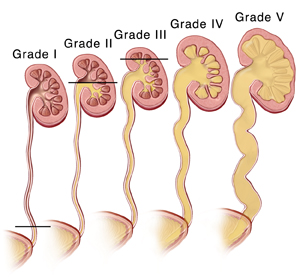
VUR
VUR is a condition in which urine flows backward from the bladder to one or both ureters and, in some cases, to the kidneys. It is not meant to flow back up. Infants and young children are the most vulnerable to VUR. VUR does not cause long-term problems in the majority of children.
VUR is typically graded from 1 to 5 by doctors. The mildest form of the condition is grade 1, and the most serious is grade 5., Sometimes a child with VUR has no symptoms. UTI is the most common cause of symptoms in children. The disorder increases the risk of urinary tract infections, which can cause kidney damage if left untreated.
These signs and symptoms can include:
- A strong, persistent urge to urinate
- A burning sensation when urinating
- The need to pass small amounts of urine frequently
- Cloudy urine
- Fever
- Pain in your side (flank) or abdomen
VUR can sometimes cause problems with bladder or bowel function. A child with VUR is more likely to suffer from
- UTIs, including bladder or kidney infections
- other bladder problems, such as urinary incontinence, bedwetting, and urinary retention
- bowel problems, such as constipation Testa and Treatment
Doctors use the following imaging tests, or tests to see organs inside the body, to help diagnose VUR
- Abdominal ultrasound.
- Voiding cystourethrogram (VCUG).
- Specialized X-ray of urinary tract system.
- Nuclear scan.
The defect in the valve between the bladder and each affected ureter is repaired during vesicoureteral reflux surgery. A flaw in the valve prevents it from closing, allowing urine to flow backward.
Methods of surgical repair include:
- Open surgery.
- Robotic-assisted laparoscopic surgery.
- Endoscopic surgery.
Make an appointment right away for consultation on your urological issue.
Call With Doctor